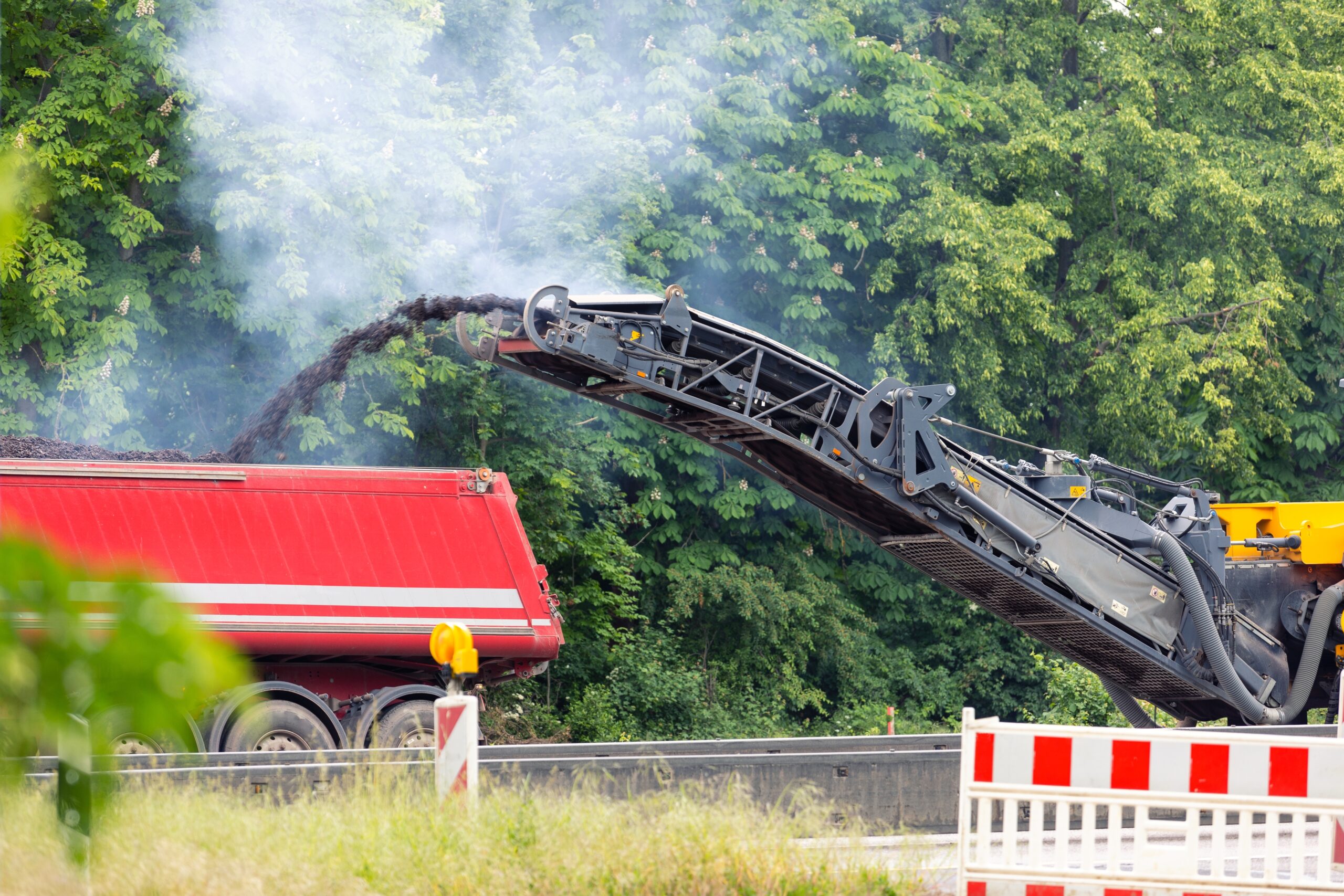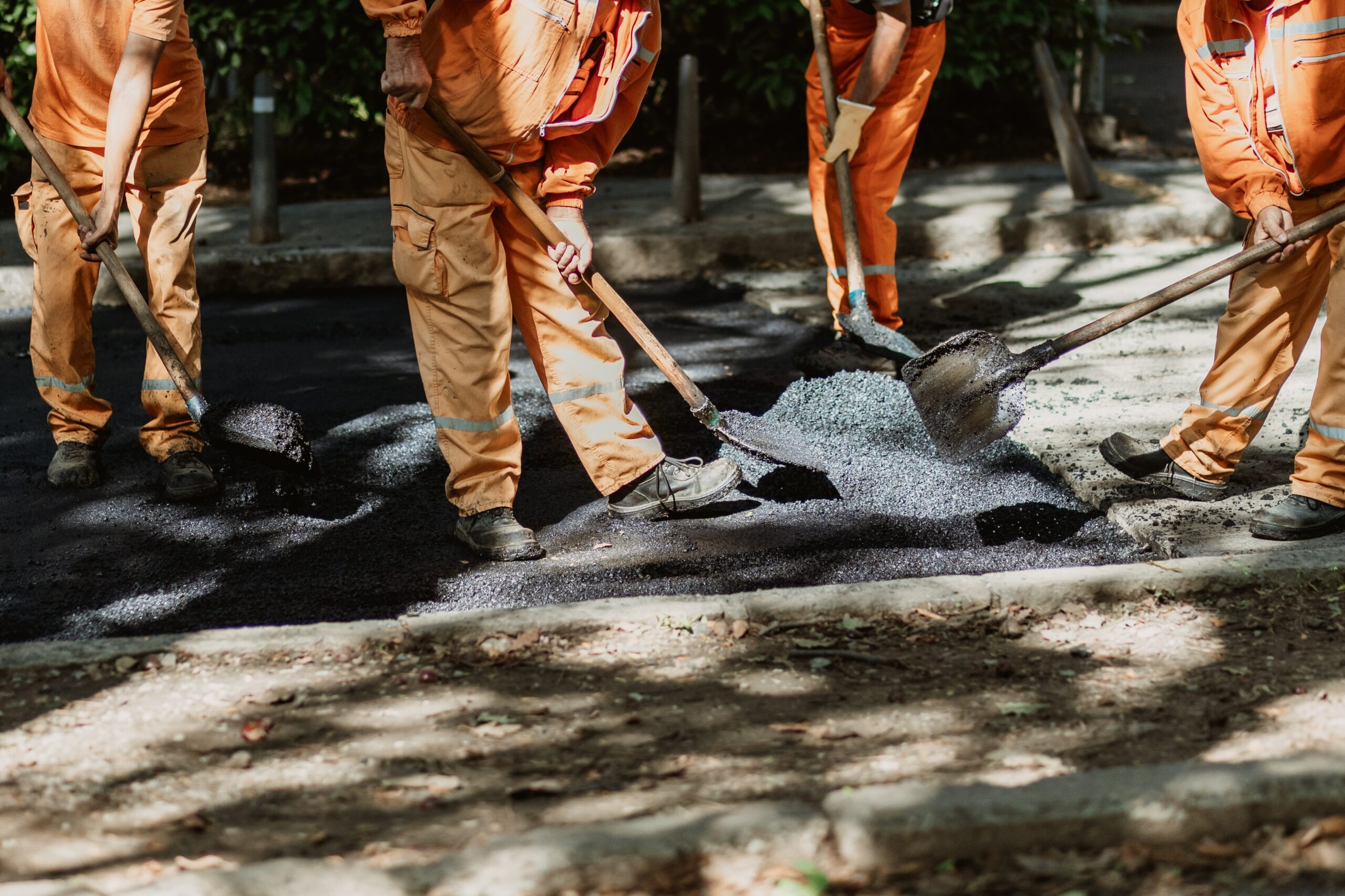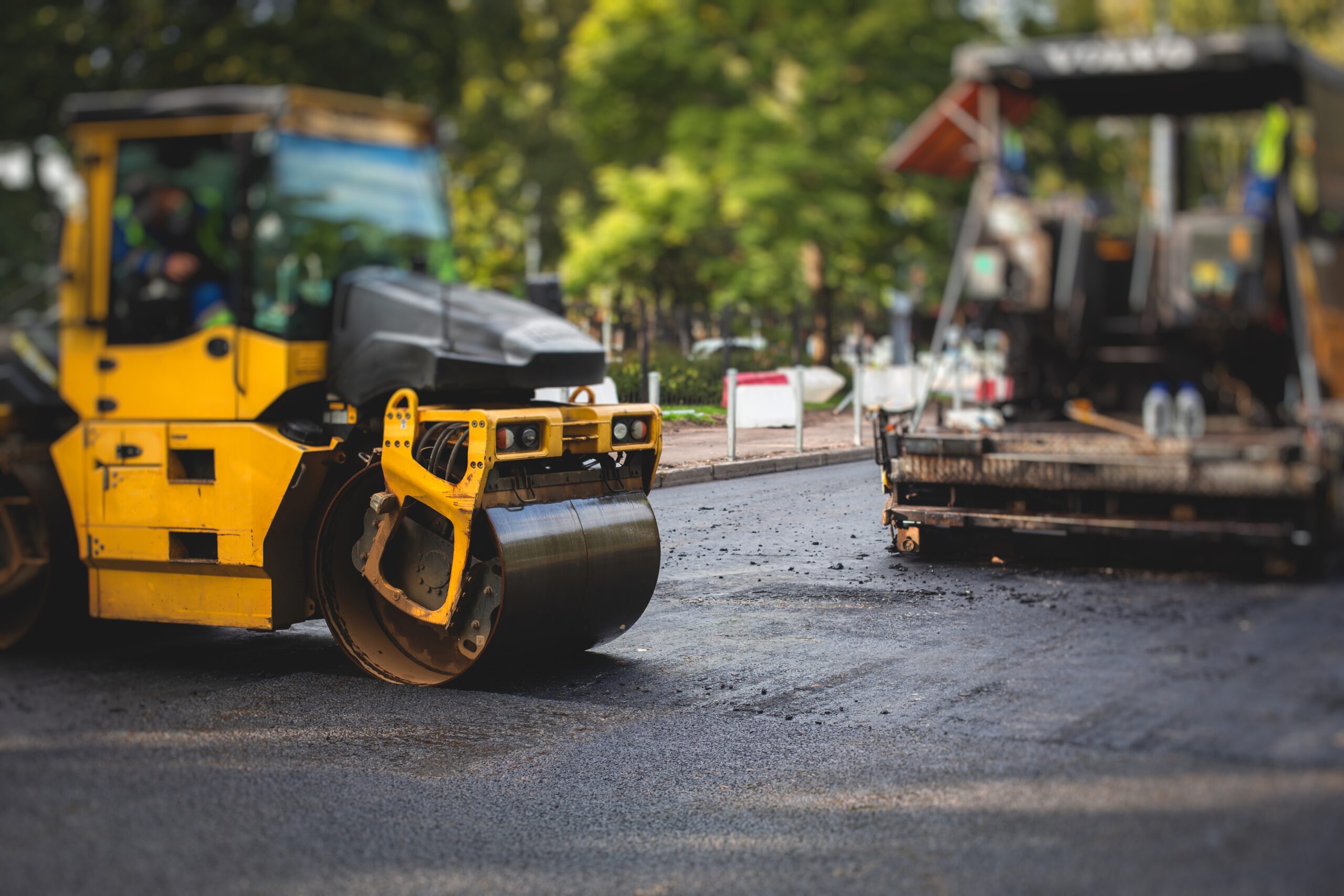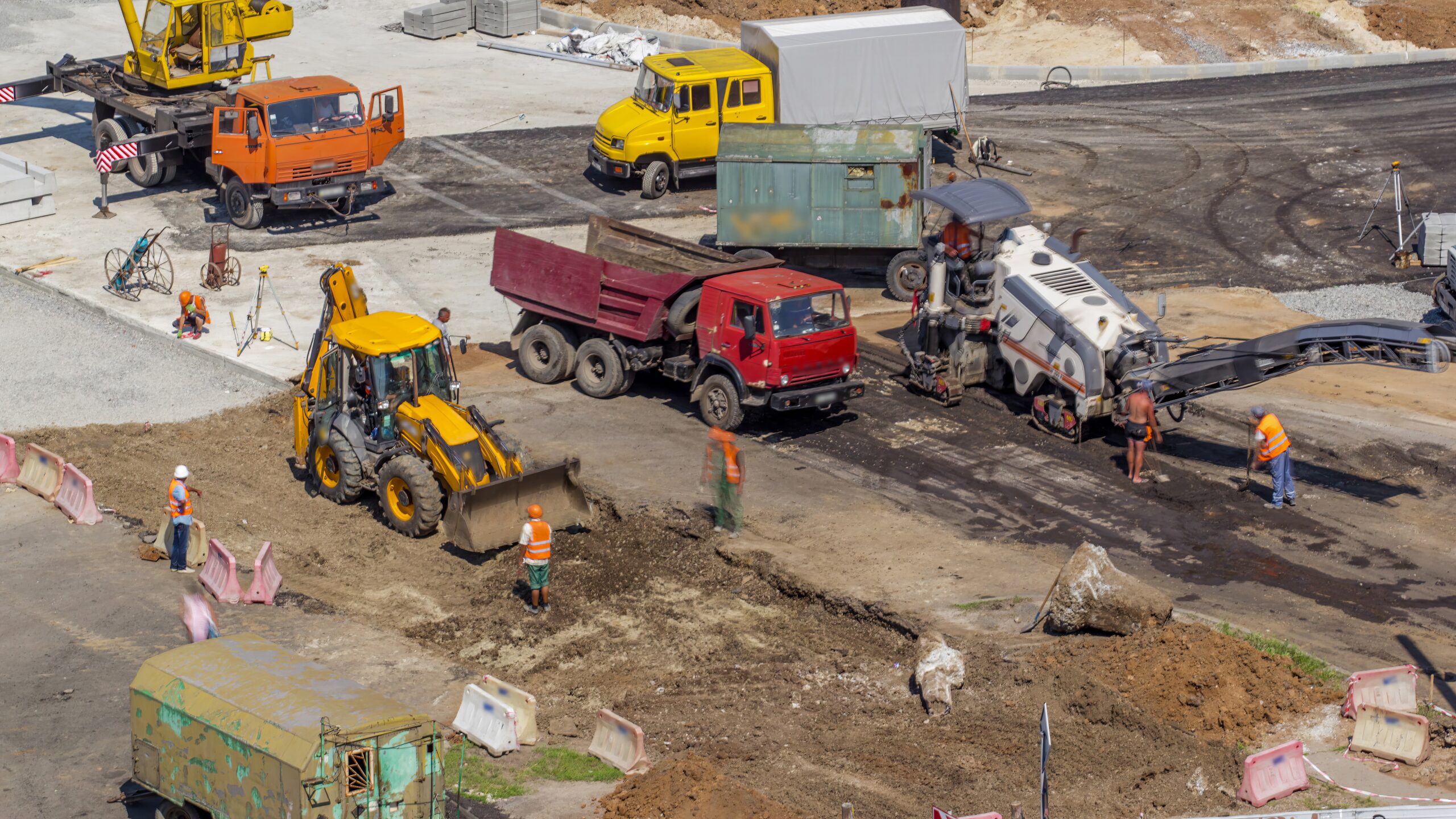
A well-maintained parking lot is critical for safety, accessibility, and liability prevention. Over time, asphalt deteriorates due to heavy traffic loads, extreme weather, and oxidation, leading to cracks, potholes, and uneven surfaces. These hazards not only compromise vehicle performance but also increase the risk of pedestrian injuries and costly legal claims.
Milling and paving provide an efficient, long-term solution. Milling removes damaged asphalt, restoring proper grading and surface integrity while preparing the base for a fresh overlay. New asphalt enhances skid resistance, eliminates pooling water, and improves visibility with fresh striping. Investing in these processes extends pavement life, boosts curb appeal, and ensures a safer, more functional parking lot for businesses and visitors.
Understanding Milling & Paving for Parking Lot Safety
The significance of a safe parking lot cannot be overstated for any commercial enterprise. It extends far beyond mere convenience; it’s a critical aspect of risk management, customer relations, and legal compliance.
Mitigating Legal Liabilities
Poorly maintained parking lots pose substantial legal risks to property owners. Deterioration in the form of potholes, pavement fractures, and inadequate drainage increases the likelihood of trip-and-fall incidents, vehicular damage, and weather-related hazards. These conditions expose businesses to premises liability claims, which can result in extensive financial losses and reputational harm.
The Occupational Safety and Health Administration (OSHA) and other regulatory bodies establish clear expectations for hazard mitigation in commercial spaces. According to the Occupational Safety and Health Administration (OSHA),
Trip-and-fall accidents are a significant concern for property owners.
Property owners who neglect necessary pavement rehabilitation measures may be held accountable for preventable injuries. By integrating asphalt milling and repaving into a comprehensive facility management plan, businesses can proactively eliminate structural defects, ensuring compliance with safety regulations while reducing exposure to costly litigation and reputational damage.
Ensuring Customer and Employee Well-Being
A properly maintained parking lot enhances safety and accessibility for both employees and customers. Surface irregularities, including deep fissures, depressions, and signs your asphalt needs immediate repair, create serious trip hazards, particularly in commercial parking lots. In adverse weather conditions, weather impacts on asphalt condition contribute to ice accumulation and hydroplaning risks, further endangering pedestrians and drivers.

By addressing pavement deficiencies through mill and pave services, businesses demonstrate a commitment to occupant safety. A smooth, properly graded surface facilitates secure pedestrian movement, minimizes vehicular impact damage, and enhances overall site functionality. This proactive approach fosters a safer work environment, boosts employee morale, and enhances customer satisfaction, ultimately reinforcing a positive brand reputation.
Enhancing First Impressions and Reputation
The condition of a commercial parking lot serves as a direct reflection of the business it supports. A neglected, deteriorating pavement surface conveys a lack of professionalism and attention to detail, which can deter prospective customers and tenants. Conversely, a well-paved, properly striped parking lot conveys competence, reliability, and a commitment to operational excellence.
Milling and paving not only enhance the structural integrity of asphalt surfaces but also improve visual appeal. Clearly defined parking stalls, smooth traffic flow, and fresh striping contribute to an organized and inviting property, reinforcing positive first impressions. For businesses that prioritize customer experience, investing in high-quality pavement maintenance is an essential strategy for strengthening brand perception and ensuring long-term success.
The Role Of Milling and Paving In Enhancing Parking Lot Safety
Asphalt milling is a controlled process of removing the deteriorated surface layer of an existing asphalt pavement using specialized machinery. This technique addresses surface imperfections like cracking, rutting, and unevenness without requiring a full reconstruction.
Milling prepares a solid base for a new asphalt overlay and improves drainage by eliminating areas where water can pool. The process involves grinding the old asphalt to a predetermined depth.
The removed asphalt, known as reclaimed asphalt pavement (RAP), is a valuable recyclable material. After milling, the surface is cleaned and prepared for paving.
The Unified Facilities Guide Specifications (UFGS) also states that Reclaimed Asphalt Pavement (RAP) from milling is recyclable, contributing to sustainable practices.
Paving for a Smoother and Safer Surface
Following the milling phase, the application of a fresh asphalt overlay is critical for restoring and optimizing parking lot safety. A new asphalt surface eliminates defects such as potholes, depressions, and surface cracking, significantly reducing trip-and-fall hazards for pedestrians while enhancing vehicular movement.
Improved Traction and Skid Resistance
Newly installed asphalt provides superior skid resistance due to its optimal aggregate composition and surface texture. This increased traction is particularly beneficial in wet conditions, as it enhances tire grip, minimizes braking distances, and reduces the likelihood of skidding or vehicle loss of control.
Elimination of Standing Water and Hydroplaning Risks
Properly engineered paving solutions incorporate precise grading and a subtle slope to facilitate efficient water runoff. By preventing water accumulation, well-constructed asphalt surfaces mitigate hydroplaning risks for vehicles and eliminate standing water that could lead to freeze-thaw damage and hazardous ice patches in colder climates. Effective drainage is a fundamental element of long-term parking lot safety and performance.
Enhanced Nighttime Visibility
Freshly paved asphalt exhibits superior light reflectivity compared to aged, oxidized pavement. This improved visibility, coupled with crisp, high-contrast pavement markings, significantly enhances nighttime safety for both drivers and pedestrians. Clearly defined parking spaces, directional arrows, and pedestrian crosswalks contribute to better traffic flow, reducing congestion and minimizing the risk of collisions in low-light conditions.
Long-Term Impact of Milling & Paving
Milling and paving are powerful tools for proactively eliminating common parking lot hazards that compromise safety and expose property owners to liability.

Eliminating Potholes & Cracks
Potholes and cracks are arguably the most visible and dangerous parking lot defects. They pose significant risks of tripping and falling for pedestrians, particularly the elderly or those with mobility issues.
For vehicles, potholes can cause tire damage, wheel misalignment, and even suspension problems. By milling away the damaged asphalt and paving a new surface, these hazards are completely eliminated, drastically reducing the risk of accidents and subsequent liability claims.
Correcting Drainage Issues
Inadequate drainage is a major contributor to parking lot deterioration and safety concerns. Water pooling on the surface not only accelerates asphalt degradation but also creates slippery conditions and unsightly puddles.
In winter, these waterlogged areas can freeze, forming dangerous icy patches that are a major cause of slip-and-fall accidents. Milling and paving, when implemented with proper grading and drainage considerations, ensure effective water runoff, preventing water accumulation and mitigating the risks associated with hydroplaning and ice formation.
Smoothing Uneven Surfaces
Uneven parking lot surfaces, characterized by ruts, depressions, and bumps, can be subtle yet still pose safety concerns.
They can cause tire wear and tear, leading to premature tire replacement. Moreover, these uneven areas can create unstable footing for pedestrians, increasing the risk of trips and falls, especially for those carrying items or pushing carts.
Milling and paving create a consistently smooth and level surface, reducing tire stress and providing a stable walking surface for pedestrians, enhancing overall safety and usability.
Enhancing Parking Lot Markings & ADA Compliance
A newly paved parking lot serves as the foundation for precise, high-visibility pavement markings that enhance organization, regulate traffic flow, and, most importantly, improve safety. Fresh asphalt allows for the application of crisp, durable striping that defines parking spaces, directional lanes, and pedestrian pathways with maximum clarity.
Maximizing Space Utilization & Traffic Efficiency
Well-defined parking stalls optimize space allocation, preventing inefficient or obstructive parking that can disrupt traffic circulation and create safety hazards. Clearly designated crosswalks establish protected pedestrian zones, reducing the risk of accidents by guiding foot traffic away from vehicle pathways. Additionally, properly marked fire lanes are essential for emergency response, ensuring unobstructed access for first responders in critical situations.
Enhancing ADA Compliance & Accessibility
Milling and paving projects provide a strategic opportunity to improve ADA compliance in parking lots.This includes properly designated and clearly marked accessible parking spaces, complete with legally required signage and access aisles. Furthermore, newly paved surfaces allow for the integration of slip-resistant, ADA-compliant ramps and pathways, ensuring safe and easy mobility for individuals using wheelchairs or mobility aids.
Beyond regulatory requirements, prioritizing ADA compliance fosters inclusivity and demonstrates a commitment to accessibility, creating a safer and more welcoming environment for all visitors while mitigating potential legal liabilities.
Long-Term Cost Savings & ROI
While milling and paving represent an upfront investment, they offer significant long-term cost savings and a strong return on investment (ROI) by proactively addressing parking lot deterioration and safety concerns.
By maintaining the structural integrity of the pavement through milling and paving, you prevent more extensive and costly repairs down the line. Addressing surface issues early on prevents them from escalating into deeper structural damage that would necessitate full-depth reconstruction, a much more expensive and disruptive undertaking. Proactive maintenance is always more cost-effective than reactive emergency repairs.
Furthermore, a safe and well-maintained parking lot reduces insurance liability costs. By minimizing accident risks and demonstrating a commitment to safety, you can potentially lower your insurance premiums. Insurance companies often view properties with well-maintained parking areas as lower risk, translating into tangible financial benefits over time.
Finally, a well-kept, safe parking lot increases property value and enhances curb appeal. A positive first impression and a safe, functional parking area are valuable assets for any commercial property.
It attracts customers, tenants, and visitors, contributing to business success and long-term property appreciation. Milling and paving are not just expenses; they are strategic investments that enhance the value and attractiveness of your property, delivering a strong ROI in the long run.
Frequently Asked Questions
How often should a parking lot be milled & paved?
Most commercial parking lots benefit from milling and repaving approximately every 10-15 years. However, this timeframe can vary based on factors such as traffic volume, climate conditions, and the initial quality of the asphalt installation. Regular inspections can help determine the optimal timing for maintenance.
How does asphalt paving improve traction and safety?
New asphalt provides a textured surface with high aggregate content, which significantly improves tire grip and skid resistance compared to aged, smooth asphalt. This enhanced traction is crucial for preventing skidding and slips, especially in wet or icy conditions, making the parking lot safer for vehicles and pedestrians.
Can milling & paving fix drainage problems?
Yes, milling and paving are highly effective in addressing drainage issues. Milling allows for regrading the surface to ensure proper water runoff, eliminating low spots and preventing water pooling. When combined with new paving, which is engineered with appropriate slopes, drainage problems can be effectively resolved.
How long does it take for a parking lot to be safe to use after paving?
Typically, a newly paved parking lot requires 24-48 hours for full curing before it can handle heavy traffic. It’s best to restrict vehicle access during this curing period to allow the asphalt to properly harden and achieve optimal durability. Light pedestrian traffic might be permitted sooner, but it’s crucial to consult with your paving contractor for specific recommendations based on the project and asphalt mix used.
How does milling affect the longevity of a parking lot?
Milling extends the lifespan of a parking lot by removing deteriorated surface layers while preserving the underlying foundation. By eliminating surface distresses such as cracking, rutting, and oxidation, milling creates a stable base for new asphalt, preventing premature failures. When combined with high-quality paving, this process significantly enhances structural integrity and durability, reducing long-term maintenance costs.
Enhance Safety, Longevity, and Curb Appeal with Professional Milling & Paving
A well-maintained parking lot is more than just an amenity—it’s a critical asset that safeguards pedestrians and drivers, reduces liability risks, and upholds your property’s professional image. Through precision asphalt milling in Denver and expert asphalt paving services in Denver, you can eliminate structural hazards, enhance surface integrity, ensure ADA compliance in parking lot design, and extend the longevity of your pavement. These are not mere maintenance measures; they are strategic investments that enhance safety, aesthetics, and long-term cost efficiency.
Don’t wait for small issues to become costly liabilities. Contact Asphalt Coatings Company today to learn how our industry-leading milling and paving solutions can restore and protect your parking lot for years to come.



